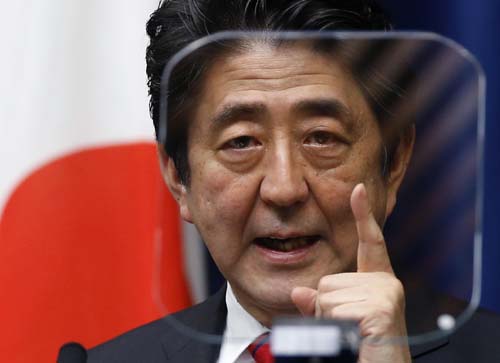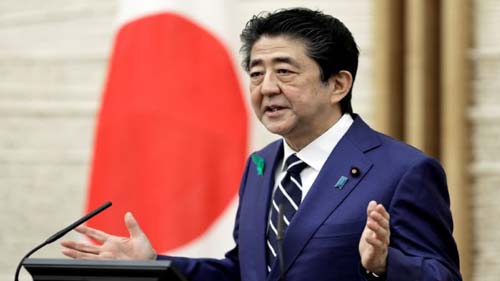
Shinzo Abe may be gone but his legacy lives on
Newswire
Tokyo: Days after the fatal shooting of former Prime Minister Shinzo Abe, Japan is still trying to come to terms with the unexpected loss of its most consequential leader in recent memory.
But while Abe may be gone, the slain politician’s life-long dream of building a brand new, fully independent and proactive Japan that is “able to defend itself” may now be closer to becoming reality than ever before.
During his two stints as prime minister from 2006 to 2007 and from 2012 to 2020, Abe pursued an ambitious economic agenda known as “Abenomics”, which sought to liberalise Japan’s stagnating economy and implement structural reforms. He also sought to revise Japan’s pacifist constitution in an effort to allow the Asian powerhouse to project military force overseas.
Before stepping down from office in 2020 over health concerns, Abe proved himself to be one of the most important statesmen in shaping the geopolitics of the Indo-Pacific in the early 21st century. He was the chief architect behind the revival of the Quadrilateral Security Dialogue (the Quad), which brings Australia, US, India and Japan together in a strategic alliance aimed at blunting China’s economic and military might in the Indo-Pacific region. He also oversaw a massive expansion in Tokyo’s strategic assistance to developing nations, especially in Southeast Asia.
Throughout his political career, Abe gained the respect of many at home and abroad for his efforts to increase his country’s international presence and to bring stability to its politics. His transformative policy positions and at times ultra-nationalistic rhetoric, however, also earned the ire of neighbouring countries such as China and South Korea, which are still haunted by Japan’s World War II atrocities, as well as progressives and religious conservatives in Japan, who lamented bouts of historical revisionism.
Abe’s assassination last week already proved to be as consequential as his life. It rallied public support for Abe’s incumbent Liberal Democratic Party (LDP) and allowed it to garner enough votes in Sunday’s legislative elections to push for realising his overreaching vision for the country – namely his dream of making Japan a “normal” country by revising its post-war constitution.
Abe’s ascent to power coincided with Japan’s relative decline in Asia, largely thanks to the resurgence of China. For most of the 20th century, Japan had served as the engine of economic growth and industrialisation across Asia. But between 1979 and 2000, due to paramount leader Deng Xiaoping’s economic liberalisation efforts, China’s real gross domestic product (GDP) increased more than six-fold. Consequently, its share of regional trade ballooned from only 8 percent in 1990 to 39 percent in 2014, with regional investment flows also following a similar trajectory.
As a result, China replaced Japan as the region’s largest economy in the late 2000s. And perhaps even more worrying for Japan, as Beijing increased its economic power, it also started investing significantly more in its military.
At the beginning of this century, Japan’s defence spending was 60-percent larger than its giant neighbour. By 2012, when Abe began his second stint in power, China’s defence spending was almost three times larger than Japan’s.

To address this seismic shift in the regional balance of power, which councided with rising Sino-Japanese territorial disputes in the East China Sea, Abe sought to reinterpret Japan’s post-war pacifist constitution and try and reform its security policy.
To this end, Japan’s longest-serving post-war prime minister moved on three fronts simultaneously. First, Abe upgraded US-Japan bilateral Defense Guidelines in 2015 in order to provide Japanese Ground Self-Defense Force (SDF) with greater operational flexibility.
Meanwhile, he vociferously advocated for a “Democratic Security Diamond” in Asia, thus overseeing the revival and institutionalisation of the Quad alliance among India, the US, Japan, and Australia. His vision of a “free and open” Indo-Pacific was largely adopted by conservative governments in Washington (Donald Trump), India (Narendra Modi), as well as Australia (Tony Abbott), who shared similar concerns about a rising China.
Abe also stepped up Japan’s foreign policy among developing nations, visiting 42 nations across Southeast Asia, Latin America and Africa between 2013-2015 alone. In particular, he pressed ahead with tighter defence, security and investment cooperation with the Association of Southeast Asian Nations (ASEAN), which has also been grappling with a domineering China.
Under Abe, Japan became the single-largest source of big-ticket infrastructure investment in Southeast Asia, worth $367bn in recent years, far surpassing even China ($255bn), while overseeing the first key military deals and high-level defence cooperation with key ASEAN nations such as Indonesia and the Philippines.
After his departure from power in mid-2020, Abe’s hand-picked successors (the country’s current Prime Minister, Fumio Kishida, was foreign minister under Abe and Abe’s brother, Nobuo Kishi, is currently serving as defence minister) continued to embrace his foreign policy doctrine.
Under Abe’s direction, Japan’s proactive foreign policy has been so impactful that China’s state-backed media started accusing Tokyo of “pursuing to be a great power like the US”. On the domestic front, however, the success of Abe’s reform agenda has been more ambiguous, if not deeply controversial.
His structural economic reforms only partly succeeded in overhauling Japan’s stagnating economy and rigid labour markets. Meanwhile, his push to revise Article 9 of Japan’s pacifist constitution, which “forever renounce[d] war as a sovereign right of the nation and the threat or use of force as a means of settling international disputes”, provoked outrage both at home, among progressives and conservative allies alike, as well as abroad, especially in Northeast Asia. And his party’s flirtation with historical revisionism – including visits by his deputies to the Yasukuni Shrine, which hosts the remains of high-level Imperial Japanese officials – only reinforced existing public opposition to Abe’s constitutional change agenda.
Following Abe’s shocking assassination last week, however, a wave of public sympathy helped the ruling LDP to consolidate its grip on both houses of the Japan’s legislature, where it now enjoys a supermajority. This victory coupled with the slow but steady shift in public opinion in favour of constitutional change amid growing anxieties or a resurgent China (an authoritative survey last year showed 48 percent of Japanese adults now support the revision of the country’s constitution), signals the possibility that former prime minister’s dreams about a new Japan may soon be realised.
Indeed, by all indications, Abe’s heirs may finally have the two-thirds majority in both houses of the National Diet needed to push for constitutional amendments. And they might even rally the 51 percent public support necessary in an eventual referendum.
Of course, only time will tell whether Abe’s ultimate vision of a proactive Japan, freed from the shackles of the American-imposed pacifist constitution will ever be realised (Neighbouring countries such as China and South Korea will likely oppose any major change in Japan’s pacifist constitution). But what is clear is that the iconoclastic leader who has transformed Japanese society and the broader Asian geopolitical landscape unlike any of his predecessors in recent memory, will continue to have an impact on the region for years after his untimely demise.
